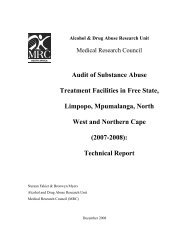Annexures 5 - SA HealthInfo
Annexures 5 - SA HealthInfo
Annexures 5 - SA HealthInfo
Create successful ePaper yourself
Turn your PDF publications into a flip-book with our unique Google optimized e-Paper software.
Annexure 25<br />
Management algorithm for hypokalemia<br />
EVALUATION<br />
• Severe vomiting or diarrhea?<br />
• Excessive fatigue or muscle<br />
cramps?<br />
• Weakness or paralysis?<br />
No<br />
ROUTINE SURVEILLANCE<br />
• Check potassium levels every 6 months for<br />
patients without history of renal insufficiency<br />
or electrolyte abnormality<br />
• Check potassium levels every 3 months for<br />
patients with history of renal insufficiency or<br />
electrolyte abnormality<br />
Yes<br />
• Check serum potassium<br />
Serum potassium ≥ 3.5 meq/L?<br />
Yes<br />
No<br />
TREATMENT<br />
Step 1<br />
Step 2<br />
Step 3<br />
Step 4<br />
• Replete potassium orally or IV<br />
• Treat associated conditions such as vomiting or diarrhea<br />
• Monitor potassium closely to determine when repletion can be stopped<br />
• Check magnesium levels if potassium does not improve with Phase 1 measures<br />
• Replete magnesium as needed<br />
• Discontinue any arrhythmagenic medications (eg. digoxin, amytriptyline, cisapride, haloperidol) )<br />
• Consider checking calcium and replete as needed<br />
If no improvement<br />
• Increase potassium and magnesium repletion<br />
• Amiloride 5-10 mg QD or spironoladone 25 mg QD may decrease potassium and magnesium<br />
wasting<br />
If severe<br />
• Consider hospitalisation and stopping the ammoglycoside

















